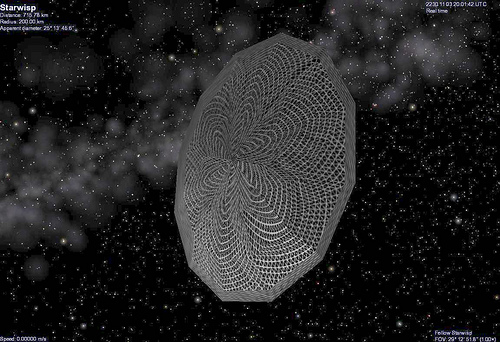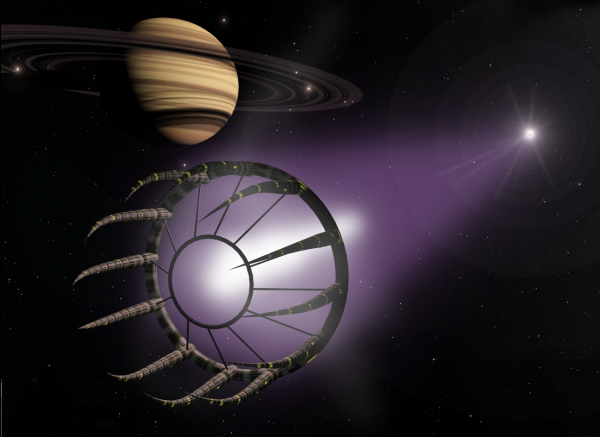BY LETTER
Beamed Energy Propulsion
Technology > Technology Type or Material > Drytech/Hylotech
Technology > Technology Levels > High Tech / Hitech
Technology > Application > Transportation > Interstellar Transport
Technology > Application > Transportation > Propulsion Technology
Technology > Technology Levels > High Tech / Hitech
Technology > Application > Transportation > Interstellar Transport
Technology > Application > Transportation > Propulsion Technology
Propulsion of craft using beamed energy, or by the use of mass particle streams | |
 Image from Steve Bowers | |
| The Starwisp class interstellar probe is a lightweight mesh propelled by a microwave laser beam, based on a concept by Robert Forward | |
The greatest drawback of the reaction driven rocket, whether it derives its energy from chemical reactions or antimatter, is the need to carry its own fuel and propellant on board. To avoid this, various kinds of passive propulsion have been developed, from the basic solar (stellar) sail which uses the light pressure of the local star for propulsion, to more advanced laser-driven concepts, which use powerful stationary lasers or masers for propulsion. Laser-propelled craft can be simple sails, or the laser beam can be used to heat propellant which is expelled to provide thrust. Other concepts such as the magsail use a magnetically constrained cloud of particles as a sail surface.
 Image from Steve Bowers | |
| The particle beam, or Beamrider, concept | |
The particle beam concept, often known as the Beamrider, uses a collimated beam of particles with mass to transfer momentum to the craft. This is the basis of the interstellar Beamrider Network, established by the Deeper Covenant long ago.
The massive particles used by a particle beam momentum transfer system may be relatively simple, such as magnetic particles propelled by a mass-driver towards the target, or small metallic light sails propelled by laser over long distances. But to maximise the transferred thrust the particles can be given rudimentary steering systems of their own, which are controlled bu automated systems to home in on the vessel to be accelerated. Such so-called smart particles can improve the efficiency of particle beam propulsion systems considerably.
 Image from Steve Bowers | |
| The G. David Nordley, an interstellar cycler ship propelled by a beam of smart particles (collected by a magnetic sail created by a superconducting loop at the rear) | |
 Image from Steve Bowers | |
| A boostbeam powered by a solar collection array. Boostbeams use local sources of power such as solar energy or planetary magnetic fields to produce propulsive beams carrying momentum. | |
Some classes of fuelless Thermal Rocket and of Electric Drive rocket use beamed power to supply energy to the drive systems. Wherever there is not enough solar energy for a solar-powered thermal or electric rocket to work, a laser or maser may be used instead.
 Image from Steve Bowers | |
| A beamrider boostbeam in orbit around a gas giant. This example extracts energy from the planet's magnetic field to power the smart particle beam. | |
Related Articles
- Beamrider Network
- Boostbeam
- Cycler
- HELL (High Energy Laser Launch)
- Magnetic Drive Sails
- New Brooklyn Beamrider Arrays
- Solar and Microwave Passive Propulsion
- Solar Wind - Text by M. Alan Kazlev
Stream of rapidly moving electrically charged particles - atoms and ions - that escape from the solar corona and blow outwards. Also called Stellar Wind.
Appears in Topics
Development Notes
Text by M. Alan Kazlev, Mauk Mcamuk, Chris Shaeffer and Steve Bowers
Initially published on 08 October 2001.
Initially published on 08 October 2001.






